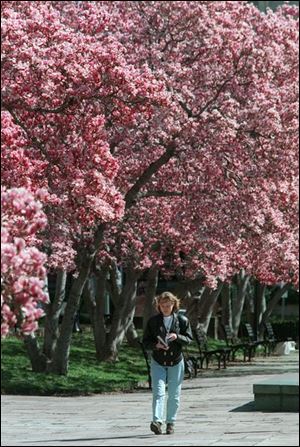
Ornamentals put pizzazz in a landscape
3/13/2002It may be too early to plant, but it is never too early to plan. A reader asked for recommendations for ornamental trees to use as a focal point for her garden design.
Here are some ornamental-tree basics to consider when planning a landscape:

Magnolia trees, such as these in Washington, bloom with huge flowers in spring.
Last week we looked at crabapple, flowering dogwood, and fruit trees. Here are more of my favorites:
Japanese maple
The Japanese maple can add a deep-purple focal point to a garden spot all summer, then steal the show again in the fall as it turns red, orange, and yellow. Look under the species name Acer in reference books. It really shows off its colors in the fall. A. palmatum is a Japanese maple that is short, but likes to spread wide. Pick a spot with partial shade and a little protection from damaging winter winds. Japanese maples can grow from five to 25 feet tall and will weep or stand upright, depending on the variety.
Magnolia
Magnolia is a huge category. Check with a local nursery to find a hardy growing variety, or visit area gardens to see what you like. This deciduous tree blooms on bare branches in the spring. It has huge white, pink, or purple flowers, grows up to 25 feet tall, and usually has more than one trunk coming from the ground.
The Saucer Magnolia, M. soulangiana, stands true to its name as it produces oversized white saucer blossoms. This centerpiece tree is also prone to disease and insects such as scale. When my magnolia tree had a bad case of scale, it also attracted something even worse - wasps and bees that like to feed on the scale's sticky sap. Look for disease-resistant varieties and keep them healthy with good growth practices and regular inspection.
Redbud
This tree is part of the Cercis species. The eastern redbud, C. canadensis, can grow up to 30 feet tall. It grows well in full to partial shade. The lavender-pink blossoms appear before the leaves sprout in the spring, so it looks like the tree has put on its best lacy dress made with small colorful blooms. The showy tree is hardy in our area.
Conifers
Trees with needles are in the evergreen group. Conifers such as pine, juniper, spruce, fir, cypress, hemlock, and cedar don't drop their leaves like deciduous trees do. This can be a blessing if you don't like to rake. Conifers are available to go with any style of garden, from a formal setting to a casual patch of wildflowers. Check with a nursery for shapely conifers to use as a focal point. The nursery also can help find the right tree for a specific site. Don't forget to mention the types of soil, light, and moisture the tree will have.
Do your homework
Choosing the right tree for a landscape is very important. If you plant a horse chestnut tree that can grow about 125 feet tall in the front yard, you are asking for disaster. Check with a nursery to find out which varieties grow best in your neighborhood.
Next week: Look for tips on picking the right spot for a tree and putting it in the ground.
Kelly Heidbreder is The Blade's garden writer. E-mail her at kheidbreder@theblade.com.